Create a WordPress searchable database for your documents

Learn how to create a searchable database in WordPress where visitors can instantly filter and find your content through search boxes, sortable tables, and dropdown filters - no coding required.
If you're managing hundreds of products, events, or member profiles on your WordPress site, you know the frustration. Visitors can't find what they need because everything's buried in chronological blog posts. They expect to filter by category, price, date, or location - just like they do on Amazon or Airbnb. But that's not how WordPress displays information.
The good news? Creating a searchable database in WordPress doesn't require any coding skills. Whether you're showcasing products, listing events, managing a member directory, or organizing resources, I'll show you exactly how to build a professional database that your visitors will love using. We'll do it using Posts Table Pro, the ultimate database plugin.
What is a searchable database in WordPress?
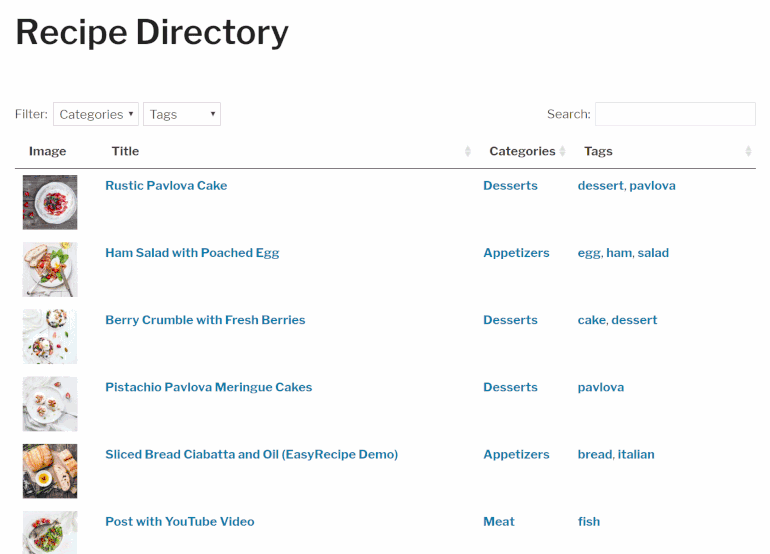
A searchable database in WordPress is a front-end system that displays content in an organized, filterable format. Unlike WordPress's default blog layout where posts appear chronologically, a searchable database presents information in structured formats visitors can navigate.
Think about how Amazon lets you filter products by price, brand, and features - that's the functionality we're creating for your WordPress content. I find that most site owners don't realize you can do this on a WordPress site until they see it in action. After that, they wonder how to get a similar searchable database for their own site!
There are lots of common applications for a searchable database. These include product catalogs with price filters, event calendars with date search, member directories with skill filters, resource libraries with categories, and real estate listings with property features. Each serves the same purpose: helping visitors find exactly what they need quickly.
The challenge is that WordPress doesn't offer this out of the box. Standard WordPress search only performs basic keyword matching. There's no built-in method to create filterable tables or grids where visitors can narrow down results.
That's where specialized plugins come in. Posts Table Pro transforms your existing WordPress content - posts, pages, custom post types, custom fields, and taxonomies - into a fully searchable database. The plugin pulls everything automatically from your WordPress database, so there's no manual data entry required.
The 4 essential components of a searchable database
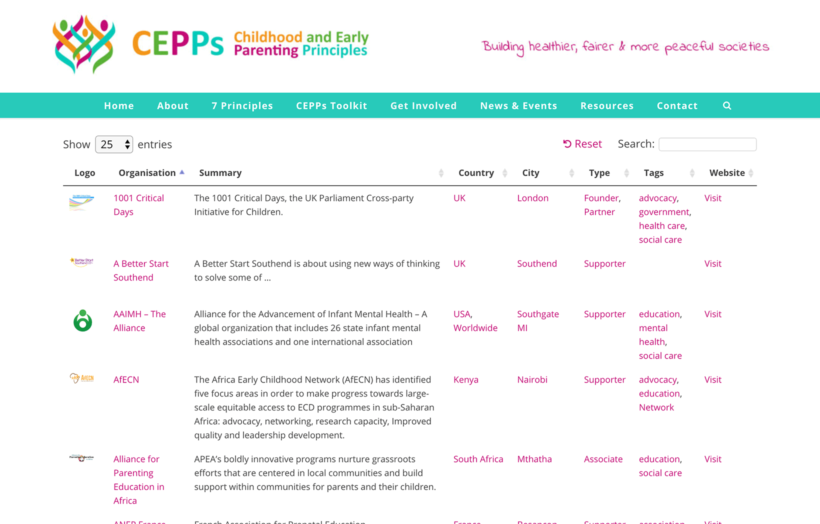
Every effective searchable database needs four components working together seamlessly:
- Structured content forms your foundation - your data organized consistently.
- Search functionality provides instant search boxes that work.
- Filtering options include category dropdowns and date pickers.
- Display formats present everything in professional-looking sortable tables, grids, or lists.
I'll tell you how to achieve all of these in WordPress.
1. Structured content - organizing your data properly
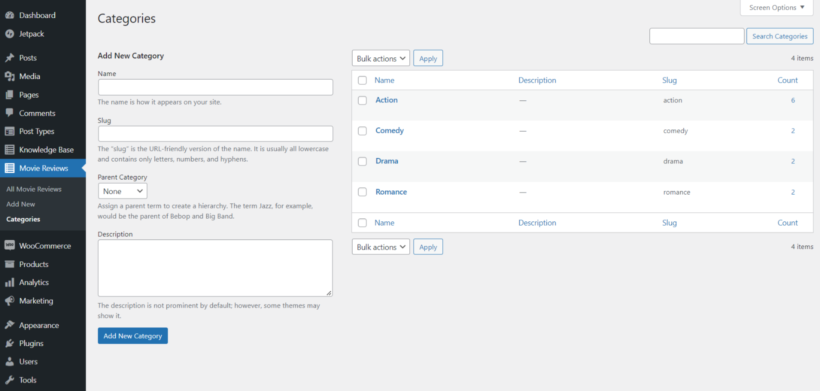
Before creating any searchable database, you need well-organized content. This means maintaining consistent data entry across all items in your database.
WordPress offers several content types to work with. Posts and pages work great for articles or standard content. Custom post types handle specialized content like products, events, or team members perfectly. Categories and tags help group related items together. Custom fields add specific details like prices, dates, or specifications that don't fit elsewhere.
Posts Table Pro works seamlessly with any WordPress content type. The plugin automatically pulls in your existing posts, pages, or custom post types without any complex setup.
I've learned that consistency is crucial here. For a product database, use consistent product names throughout. Standardize your categories - choose "Laptops" not a mix of "Laptop" and "Notebooks". Fill in all relevant custom fields for every item. These small details make a huge difference in search accuracy.
Common organization mistakes I see include mixing different content types in one database, using inconsistent category names, leaving key information fields empty, and having no clear taxonomy structure. Avoid these pitfalls and your searchable database will function smoothly.
The beauty of Posts Table Pro is how it handles all these content types automatically. Whether you're displaying blog posts, WooCommerce products, or custom post types, the plugin adapts to your content structure. This means that you don't need to update the database when you add, edit or remove entries - the front end changes happen automatically ✨
2. Search functionality - making content instantly findable
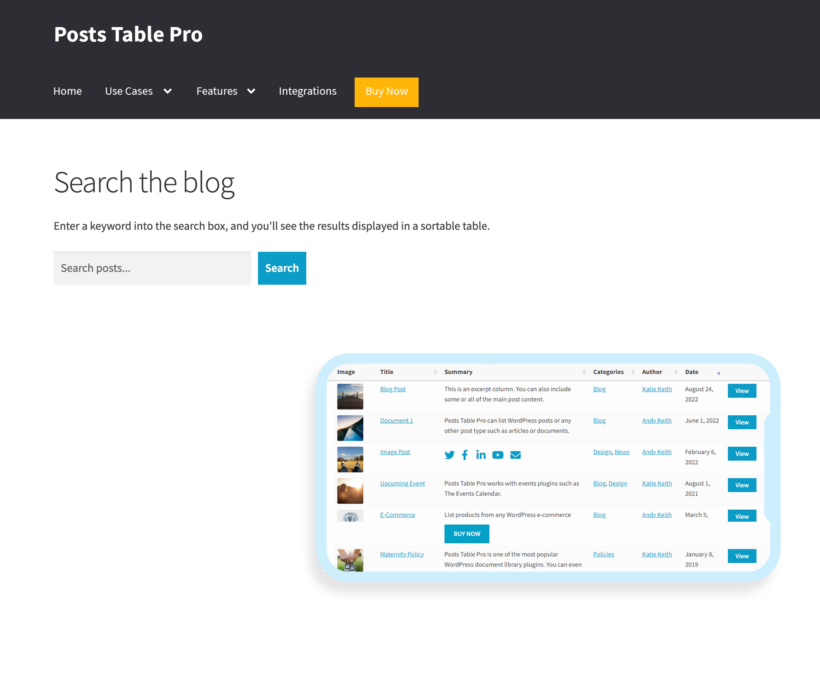
A search box forms the cornerstone of any database, and visitors expect instant results as they type - not page refreshes and waiting. Your searchable database needs several essential features to meet these expectations:
- First and foremost, instant search should display results as users type, giving them immediate feedback. This works best when combined with multi-field search that checks titles, content, and custom fields simultaneously.
- You can combine search with category and tag filters for even more precise results.
- Posts Table Pro includes AJAX-powered instant search automatically - just add a standalone database search widget or use the search box which appears above the database. Either way, your visitors get Google-like instant results.
- The plugin searches comprehensively, checking post titles, content descriptions, categories and tags, custom field values, and even author names and other data. This broad approach ensures visitors find what they need regardless of where that information lives in your database.
- Performance becomes crucial when dealing with large databases. I've seen sites with thousands of entries bog down with poorly optimized search, but Posts Table Pro offers lazy loading to maintain speed. Only visible results load initially, which prevents those frustrating slow page loads that drive visitors away.
- The search experience is also highly customizable. You can place the search box above or above your database.
Here's how this works in practice: imagine an event database where users can search "conference" to instantly see all conferences, or type "New York" to find location-specific events. For even more advanced capabilities, you can enhance Posts Table Pro with SearchWP to add features like synonym matching, and relevance weighting.
3. Filtering options - helping users narrow results
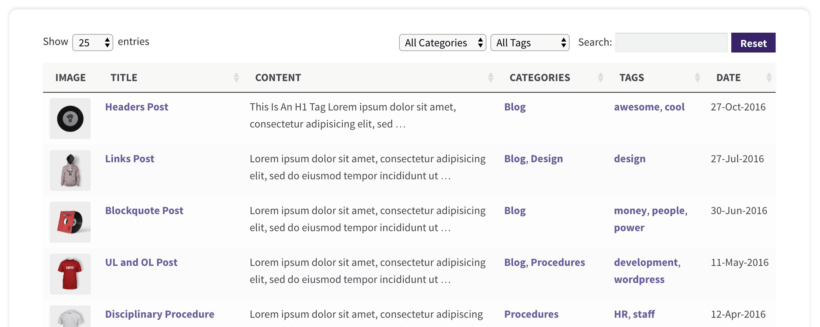
Search alone isn't enough for a true searchable database. Users need filters to drill down to exactly what they want without endless scrolling.
You can add a wide range of filters above your searchable WordPress database:
- Category filters to search by post category. (Best for databases of blog posts.)
- Tag filters to filter by specific labels.
- Custom taxonomy filters to filter by any other data such as year, publisher, country..... the possibilities are endless. (Best for custom content types.)
For example, you might include dropdown filters for categories and custom taxonomies, and date range pickers for events or deadlines. You might add price or number ranges for product databases, and checkbox filters for multiple selections. Each serves a specific purpose in helping visitors narrow their search.
The search filters in Posts Table Pro update dynamically based on available content. Multiple filters work together - combine category with date range for precise results. The reset button clears everything at once when visitors want to start fresh.
When planning your filters, I recommend considering how your visitors think about your content:
- Use clear, descriptive category names that visitors understand, and avoid making them too long.
- Limit top-level categories to 5-10 for better usability.
- Instead, create logical hierarchies with parent and child categories.
In this example, a member directory has location dropdowns and a skill filter. Each filter type matches how visitors naturally search for experts:
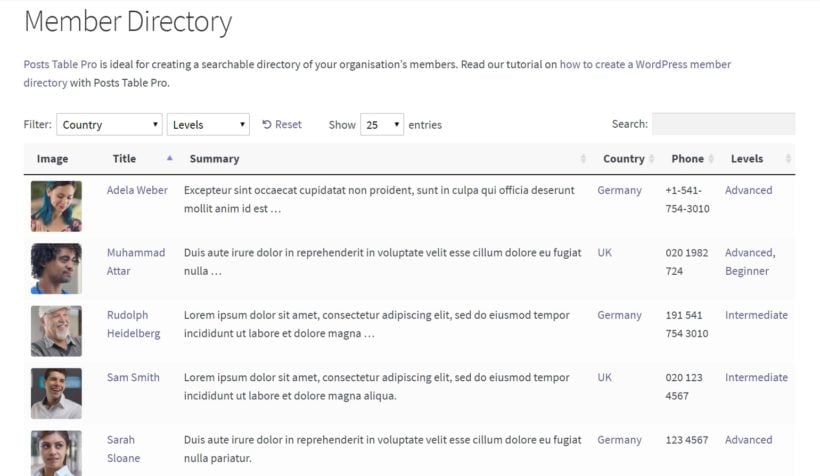
Creating different types of searchable databases

Posts Table Pro adapts brilliantly to whatever content you throw at it. Let me walk you through some of the most popular database types I've helped people create:
- For product catalogs, you can display WooCommerce or Easy Digital Downloads products complete with price filters, category search, and add-to-cart buttons right in the table. Customers can browse and buy without constantly clicking through to individual product pages - it's like giving them a wholesale order form.
- Event directories work beautifully with date filters, location search, and registration links built right in. I've seen conference organizers use this to let attendees quickly find relevant sessions, and community groups use it for local event calendars. The date filtering is particularly smooth.
- Member or staff directories become genuinely useful when you add role filters, department categories, and contact information. Instead of making visitors scroll through endless profile pages, they can search for "marketing manager" or filter by location and instantly find who they need.
- For document libraries, you have a choice. Posts Table Pro handles general content really well. However, if you need specialized features like download tracking and folder structures, our other plugin - Document Library Pro - is purpose-built for document management.
- Real estate listings shine when you add filters for price range, number of bedrooms, location, and property type. Buyers can narrow down hundreds of properties to just the ones that match their criteria in seconds.
- Course catalogs benefit from filters for topic, difficulty level, instructor, and enrollment status. Students can quickly discover which courses fit their schedule and skill level without reading through every course description.
The beauty is that each database type uses the same Posts Table Pro foundation. You're just customizing which columns appear and which filters make sense for your specific content. It's surprisingly simple once you get the hang of it.
Build your searchable database in WordPress today
Creating a searchable database in WordPress sounds technical, but it's actually straightforward when you have the right tools. You need four things: organized content, search functionality, smart filters, and a professional display. Posts Table Pro delivers all of them without any coding required.
Here's your action plan to get started:
- First, spend some time organizing your content with consistent categories - this is the foundation everything else builds on.
- If you haven't already added the content that you want to display in the database, then use the free Easy Post Types & Fields plugin to create a custom post type for storing the information.
- Then install Posts Table Pro (it takes about two minutes).
- Now use the table builder to create your first table, and insert it onto any page or your site. (You can also add different databases to different pages.)
- Finally, customize the columns and filters to match what your visitors need.
The whole process usually takes less than an hour, even if you're including custom fields and complex filters. Compare that to hiring a developer or trying to code it yourself 🚀
Whether you're building a product catalog, member directory, or resource library, Posts Table Pro transforms your WordPress content into the kind of professional searchable database that visitors actually enjoy using. You're not starting from scratch - you're enhancing what you already have.
I've been using Posts Table Pro for quite a while now. It's become a major part of my website and I don't know how I managed without it. I've got a huge table with more than 900 titles/pages (stories) and use it to sort/filter/search.
Ståle GismervikVerified Customer
Get Posts Table Pro today and watch your WordPress content transform into a powerful searchable database that actually helps visitors find what they need.